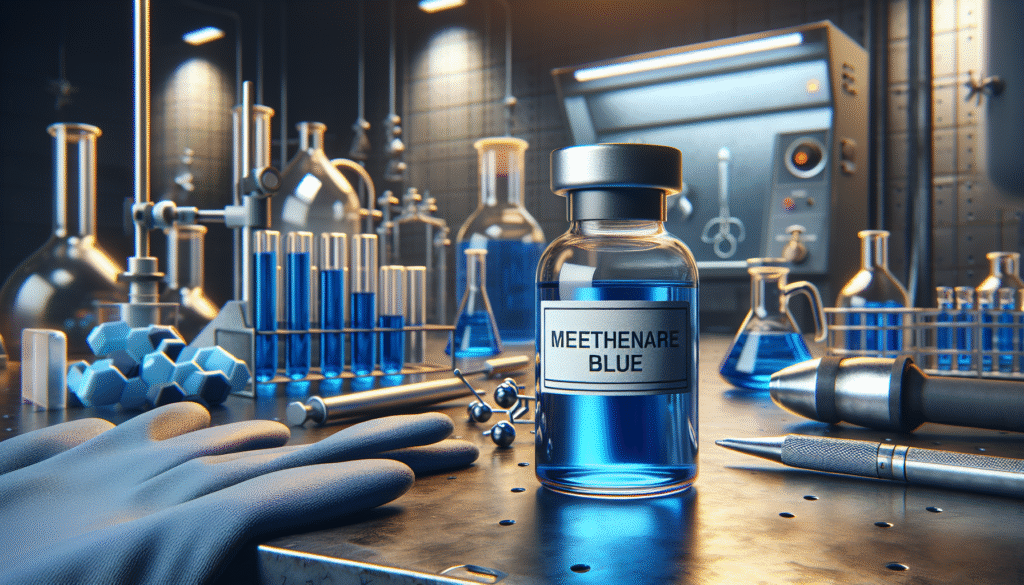
Have you ever wondered about the proper protocols for safely storing methylene blue? Understanding the best practices for this chemical is vital, not only for ensuring safety but also for maintaining its effectiveness. Methylene blue, a versatile dye and medication, has numerous applications in various fields, including biology, chemistry, and medicine. Given its potential hazards, it’s crucial to know how to handle and store it correctly.

Understanding Methylene Blue
Methylene blue is a synthetic dye with various applications, including use in biological staining and as a medication for certain medical conditions. Its chemical structure is complex, and its interactions can be sensitive to environmental factors. Therefore, a comprehensive understanding of its properties is critical for safe storage.
Chemical Properties
One of the essential aspects of methylene blue is its chemical structure, which affects its stability and reactivity. Methylene blue is a thiazine dye, predominantly known for its deep blue color. It is soluble in water and polar solvents, which necessitates careful consideration when storing to avoid reactions with other substances.
Applications
Methylene blue finds its way into numerous fields:
- Biological Staining: It is often utilized in microbiology and histology for staining cells and tissues.
- Medical Uses: This compound is employed in treating methemoglobinemia and as an antiseptic agent.
- Research: In laboratories, it serves as a redox indicator and a tool in various biochemical experiments.
Understanding its diverse applications provides insight into why safe storage is paramount.
Importance of Safe Storage
The importance of safe storage for methylene blue cannot be overstated. Proper handling reduces the risk of chemical accidents and ensures the integrity of the substance. Inappropriate storage can lead to degradation and compromised effectiveness, which can render it useless or even dangerous.
Health Hazards
Exposure to methylene blue can pose health risks, including irritation to skin and mucous membranes, as well as systemic toxicity if ingested. Understanding these hazards reinforces the necessity of safe storage practices.
Environmental Risks
Methylene blue’s solubility in water makes it a potential environmental hazard. Improper disposal or leaks can contaminate water sources, leading to ecological damage. Awareness of this risk highlights the importance of responsible storage and handling procedures.
Best Practices for Storing Methylene Blue
Implementing the best practices for the storage of methylene blue ensures safety and efficacy. Consider the following guidelines to foster a safe environment:
1. Container Selection
The choice of container is critical when storing methylene blue.
Recommended Materials
| Material | Benefits |
|---|---|
| Glass | Non-reactive and impermeable |
| High-Density Polyethylene (HDPE) | Resistant to chemicals |
Opt for containers that are opaque or amber-colored to mitigate light exposure, which can degrade methylene blue.
2. Storage Location
Choosing the right storage location can drastically influence the stability of methylene blue.
Ideal Conditions
- Cool Environment: Store in a cool place, ideally between 15°C and 25°C (59°F and 77°F).
- Humidity Control: Keep humidity levels low to prevent any adverse reactions with moisture.
Consider a locked cabinet or designated storage area that’s away from direct sunlight, heat sources, and incompatible chemicals.
3. Labeling and Signage
Accurate labeling of methylene blue containers enhances safety by informing individuals of the contents and associated hazards.
Labeling Essentials
- Chemical Name: Clearly state “Methylene Blue.”
- Date: Include the date of purchase or preparation.
- Hazard Information: Note any hazards, including toxicity or reactivity symbols.
Proper signage in the storage area can further reinforce safety measures and ensure that all personnel are aware of the potential risks.
4. Regular Inspections
Conducting regular inspections of stored methylene blue is crucial to ensure that containers remain secure and that the chemical is still effective.
Inspection Checklist
- Container Integrity: Check for leaks, cracks, or discoloration.
- Environmental Conditions: Monitor temperature and humidity levels.
- Expiration Dates: Regularly verify and update expiration dates.
Establish a routine for these checks, ensuring that any changes are promptly addressed.
5. Training and Procedures
Training personnel in safe handling and storage procedures is essential for promoting a culture of safety within the organization.
Key Training Components
- Personal Protective Equipment (PPE): Ensure that everyone understands the necessary PPE, including gloves and eye protection.
- Emergency Procedures: Establish clear protocols for spills, accidents, or exposure incidents.
Encourage questions and discussions about methylene blue storage to foster a comprehensive understanding among staff.
Additional Considerations
When establishing storage protocols, consider additional elements that may influence overall safety and efficacy.
1. Compatibility with Other Chemicals
Methylene blue can react with various substances, potentially leading to hazardous situations.
Incompatibilities
| Chemical Type | Examples |
|---|---|
| Oxidizing Agents | Potassium permanganate |
| Reducing Agents | Sodium hydrosulfite |
| Strong Acids and Bases | Hydrochloric acid, Sodium hydroxide |
Evaluate the compatibility of methylene blue with other chemicals stored in the vicinity and segregate incompatible substances to reduce risks.
2. Waste Disposal
Proper disposal of expired or unused methylene blue is as important as its storage.
Disposal Protocols
- Follow Local Regulations: Adhere to environmental agency guidelines for hazardous waste disposal.
- Neutralization: Depending on local regulations, consider neutralizing methylene blue before disposal.
Engaging environmental safety officers for guidance on proper disposal techniques ensures compliance with regulations and promotes ecological responsibility.
3. Emergency Preparedness
In the event of an emergency involving methylene blue, having a plan in place is crucial.
Emergency Equipment
- Spill Kits: Ensure access to spill control kits appropriately equipped to handle chemical spills.
- First-Aid Supplies: Have readily available first-aid materials for immediate response to exposure incidents.
Regular drills for potential emergency scenarios ensure that personnel are familiar with the procedures and equipment.

Conclusion
Storing methylene blue safely is a crucial responsibility that cannot be overlooked. Adhering to best practices in terms of container selection, environmental conditions, labeling, and training enhances safety not only for individual users but also for the broader environment. By committing to these guidelines, you foster a culture of safety that respects both the chemical’s efficacy and the health of all personnel involved.
Invest in understanding the nuances of handling methylene blue, and engage continuously in discussions and training. Your proactive measures today can prevent accidents tomorrow and ensure that methylene blue remains a reliable resource in your applications.